|
26707
2nd Corporal Figure
1. (Photograph
from the Mathieson family tree courtesy of Linda Briggs) |
|
|
26707
2nd Corporal Figure
1. (Photograph
from the Mathieson family tree courtesy of Linda Briggs) |
|
|
|
767
Sergeant Figure
2. (Photograph
from the Mathieson family tree courtesy of Linda Briggs) |
Lieutenant
Colonel Edward De Santis, MSCE, P.E., MInstRE
(2002, revised July 2022)
1. INTRODUCTION
This research project was prompted by the author's acquisition of two groups of medals belonging to men of a family named Matheson[1] from Helmsdale, Scotland. Since the medals were purchased from the same dealer and the dealer listed them as a family group, it has been assumed that these two groups of medals belonged to a father and son. This assumption takes on great significant during the course of this research. If the assumption is incorrect, then some parts of the research also will be incorrect.
A search for the Great War service papers of 2nd Corporal J.T. Matheson at the Public Record Office[2] at Kew, Richmond, Surrey was unsuccessful. Since no copies of his papers were available, this research work is, perforce, quite abbreviated from what was hoped for when his medals were acquired by the author. Nevertheless, based on the unit that he served with during the war, his story is an interesting one so far as it has been able to be reconstructed. A copy of the war diary for the unit in which J.T. Matheson served was found in The National Archives. As with most war diaries from the Great War the writing is difficult to impossible to read in many places. Some effort has been made to study the pages of the diary to provide greater detail regarding Matheson’s service, but little additional information could be found.
PART
I
John Sandison Matheson (presumably the father of James Thomas Matheson) served in the 1st Caithness Volunteer Artillery.[3] This is known from the fact that Sergeant Matheson was awarded the Volunteer Long Service Medal (VR)[4] and the medal is named to him as:
767 Sergeant J.S. Matheson: 1 Caith: Vol. Art.
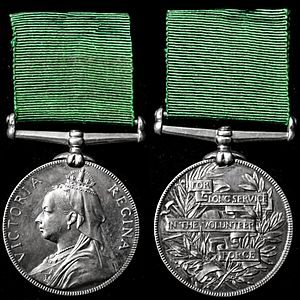
Figure 3. The Volunteer Long
Service Medal of 767 Sergeant J.S. Matheson.
(Images from the author’s collection)
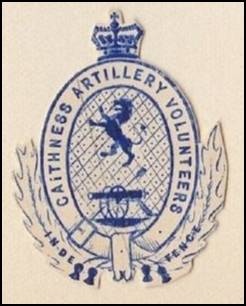
Figure 4. Badge of the Caithness Artillery Volunteers.
(Image courtesy of Wikipedia)
The history of the Caithness Volunteer Artillery began in 1863 when the 1st , 2nd , and 3rd Caithness, 1st , 2nd , 3rd , and 4th Orkney, and 1st Ross Artillery Volunteer Corps were formed into the 1st Administrative Brigade, Caithness Artillery Volunteers, with headquarters at Wick. Wick is town on the east coast of Scotland located about 14 miles south of Duncansby Head, the northeastern-most tip of Scotland, and about 30 miles northeast of Helmsdale. In 1867 the Orkney and Ross corps were withdrawn from the brigade, and to it were added the 1st Sutherland Artillery Volunteers, Helmsdale, and the 2nd Sutherland Artillery Volunteers, Golspie. In 1880 the brigade was consolidated as the 1st Caithness Artillery Volunteers with headquarters at Wick. The brigade consisted of eight batteries. No. 7 Battery (the late 1st Sutherland Artillery Volunteers) was located at Helmsdale. Sergeant Matheson probably served in this battery of the 1st Sutherland Artillery Volunteers, since the unit was located in his hometown.[5]
J.S. Matheson also was an athlete. Besides his Volunteer Long Service Medal, the Matheson group also contained a hexagonal, one-inch wide, plain silver watch fob engraved as follows:[6]
Presented
To
J.S. Matheson
By
THE HELMSDALE
Athletic Club
12th Jan. 1880
PART II
JAMES THOMAS MATHESON (aka Mathieson)
Enlistment
James Thomas Matheson may have enlisted in the Royal Engineers specifically for service in the Great War of 1914 to 1918; however, based on his Regimental Number (26707), it appears that Matheson may have enlisted before the war, as indicated his low 5-digit Regimental Number which normally was issued to soldiers in the Regular Army.
Training
Following his attestation he was posted to the School of Military Engineering (S.M.E.) at Chatham, Kent where he received his basic training as a Sapper. Sapper Matheson passed through the S.M.E. in 202 Party and was awarded a bronze medal as “Best Shot” in his party.[7] This medal is erroneously named to him as J. Mathieson.
2. ASSIGNMENTS AND
CAMPAIGN SERVICE
Chatham
(1914-1915)
Upon the completion of his training at Chatham, Matheson was assigned to the 3rd Field Squadron, Royal Engineers[8] serving in the 3rd Cavalry Division of the British Cavalry Corps.[9] This squadron was one of the “Old Contemptible” units of the original British Expeditionary Force. Sapper Matheson, however, did not join the unit until sometime in the early part of 1915 while the 3rd Cavalry Division already was in France and Flanders[10].
The 3rd Cavalry Division had been formed at Windmill Hill Camp in Ludgershall in September of 1914.[11] The division left Ludgershall on 5 October and began embarkation for France at Southampton on 6 October. It disembarked at Ostend on 8 October and on the following day the division moved forward to Bruges. Operating under the control of the British IV Corps, the division took part in the operations at Antwerp and in the battles of Ypres and Langemarck during October and November of 1914. The 3rd Cavalry Division was then transferred to the British I Corps and saw action in the battles of Gheluvelt and Nonne Boschen.
The 3rd Field Squadron, Royal Engineers also was formed at Ludgershall on 16 September 1914. The Officers originally posted to the squadron at Windmill Hill Camp were:[12]
Captain C.E.P Sankey, R.E.[13]
Lieutenant J.C. Bowles, R.E.
2nd Lieutenant R.D. Park, R.E.
2nd Lieutenant J. Kiggall, R.E.
On 5 October 1914 while the squadron was at Portsmouth, 2nd Lieutenant R.C.F. Dodgson was posted to the company. It is not known if Dodgson was an engineer officer, as the war diary entry shows (Interpreter) after his name rather than the customary “R.E.”
The squadron embarked on 12 October, disembarked at Boulogne on the 14th and joined the division in Belgium on 19 October 1914 during the battle of Ypres. Sapper Matheson was still at Chatham at this time undergoing recruit training when the squadron saw its first action.
France
and Flanders (1915-1919)
By way of introduction it should be noted that the following descriptions
of the movements and actions of Matheson’s unit, the 3rd Field
Squadron with the 3rd Cavalry Division, have been taken primarily
from the Royal Engineers Journal articles cited in the References.
1915
If Sapper Matheson joined the 3rd Field Squadron in the spring of 1915, then he may have joined it during the 1915 phase of the battle of Ypres. Lieutenant John Campbell Bowles had been promoted to Captain prior to the battle and had been killed in action on 19 February 1915.[14]
The squadron saw action at St. Julien from 24 April to 4 May 1915, at Frezenberg from 8 to 13 May 1915 and at Bellewaarde from 24 to 25 May 1915 (see ANNEX A).[15] During these actions the squadron was under the command of Captain Victor Herman Simon, R.E. Simon had joined the squadron on 7 March 1915 and would be killed in action near Ronssoy on 5 June 1917.
The squadron next saw action at the battle of Loos from 25 September to 5 October 1915.[16] On 16 June 1915, prior to that battle, 2nd Lieutenant Theodore Smith joined the squadron.[17]
During the battle of Loos, Captain Victor Herman Simon, R.E. commanded the 3rd Field Squadron. He was awarded the Military Cross for his actions during that battle. The citation for his M.C. reads as follows:[18]
“For conspicuous ability and energy at Loos on 27th September, 1915. Although it was practically daylight when he arrived at Loos, he at once grasped the situation, put his two troops to work and materially assisted in consolidating the position held by a cavalry brigade.”
1916
From 1 to 13 July 1916 the 3rd Field Squadron fought on the Somme at Albert, where it was attached to the British XVIII Corps. The squadron returned to the control of the 3rd Cavalry Division from 23 July to 3 September 1916 during the battle of Pozieres. After this battle the Cavalry Corps moved to Regnere Ecluse for the winter with the 3rd Cavalry Division moving to the west of Hesdin. On 4 October 1916 the 3rd Field Squadron went forward to the vicinity of Couin in the Reserve Army area for work on water points near Colin Camps and on a cavalry track which was subsequently not used. The squadron was withdrawn from that area on 31 October. In November the squadron settled into winter quarters at Les Puits Berrault.
1917
On 10 February 1917 a preliminary reconnaissance was carried out by the squadron for cavalry tracks east of Arras. On 11 March detachments of the 3rd Field Squadron with dismounted men from the 3rd Cavalry Division commenced work on these tracks. The division was moved east of Arras on 9 April where it came under the command of the Third Army and on 11 April the division was located east of Crecy with the 3rd Field Squadron located at Wadicourt. Matheson saw action during this period in the battle of the Scarpe between 9 and 14 April, with his squadron attached to the 1st Cavalry Division. On 9 May the 3rd Cavalry Division moved to the Peronne area and moved into front line positions between the Omignon and Cologne Rivers along with the remainder of the divisions of the Cavalry Corps. While in the front line a great deal of effort was put into improving defensive positions. On 7 June Major V.A. Simon, R.E., M.C., Officer Commanding, 3rd Field Squadron, was killed east of Ronssoy.
On 3 July the 3rd Cavalry Division moved up to the First Army area and on 5 July the Cavalry Corps handed over their trenches to the III Corps and the 3rd Cavalry Division moved to Busnes, near Lillers. On 26 July the 3rd Field Squadron moved to Westoutre to prepare for operations in the Second Army Area. They were employed on water points, a Corps Reinforcement and Remount Camp near Bailleul and on the preparation of an Advance Corps headquarters at Dickebusch and later at Poperinghe.
From 16 September detachments from the 3rd Field Squadron worked on the construction of huts and stables for the Corps in the area between the Cologne and Omignon rivers. In the middle of October the entire squadron was moved down for hutting work to Brusle and Flamicourt and at the end of October preparations for the Cambrai operations were started and a detachment of the squadron constructed water points for three divisions and an Advanced Corps headquarters at Fins. A bridge for crossing the St. Quentin Canal was prepared by Lieutenant H.D. Maconochie of the 3rd Field Squadron and the bridge was arranged for loading on to two tanks. The squadron then took part in the battle of Cambrai from 20 November to 3 December 1917. The squadron was employed on the construction of support lines and strong points. Lieutenant Maconochie’s bridge was used to improve an existing bridge east of Masnierres and facilitated the withdrawal of the Canadian Cavalry Brigade. For his work and the work of his troop on this bridge Maconochie was awarded the Military Cross.
1918
The squadron next fought at St. Quentin from 21 to 23 March 1918 and at Avre on 4 April 1918. From 3 to 8 April the 3rd Field Squadron was employed on the Cachy Switch and on 10 April the squadron moved to Sains-les-Pernes. By 5 May the squadron was at Behencourt in the Fourth Army Area. On 16 May the 3rd Cavalry Division withdrew to the Yvrench area and the 3rd Field Squadron moved to the Bettencourt-St. Ouen area. On 3 July the squadron moved to Dreuil and remained there until 30 July were it worked on rear defences using Chinese labour under the Chief Engineer, Fourth Army.
On 6 August the Cavalry Corps Headquarters moved to Yzeux and the cavalry divisions concentrated west of Amiens for the Fourth Army attack. The 3rd Field Squadron then took part in the action at Amiens from 8 to 11 August 1918. The squadron prepared tracks through the trenches for the 3rd Division and reconnoitered the crossings over the Luce and by 25 August it was at Haravesnes. In the highly mobile phase of the last year of the war, during the pursuit of the Germans to Mons, Matheson's squadron saw action at the St. Quentin Canal between 29 September and 2 October 1918, at Beaurevoir from 3 to 5 October 1918 and at Cambrai on 8 and 9 October 1918.
On 11 November 1918, the leading troops of the 3rd Cavalry Division had reached the line of the River Dendre at Leuze and Lessines. That night the division was withdrawn to the east of the River Schelde near Tournai. Instructions were received on 15 November that the 3rd Cavalry Division would cover the advance of the British Second Army. On 17 November the division moved forward and on 21 November established its headquarters at Waterloo. By 11 December the 3rd Field Squadron had settled into winter quarters at Schlessin.
1919
Beginning in December of 1918, demobilization of the 3rd Cavalry Division was gradually carried out and on 31 March 1919 the division ceased to exist. Thus the war ended for Matheson and the men of the 3rd Field Squadron, Royal Engineers. Although the squadron had participated in many battles during the war, the number of fatal casualties suffered by the unit was surprisingly small. The following table is a summary of the men of the squadron who were lost during the war:[19]
|
Name |
Regimental
Number |
Rank |
Cause
of Death |
Date
of Death |
|
Simon, Victor Herman |
|
Major |
Killed in action |
5 June
1917 |
|
Bowles, John Campbell |
|
Captain |
Killed in action |
7 March
1915 |
|
Chappell, E.F. |
|
2nd Lieutenant |
Killed in action |
3 February
1916 |
|
Barber, Arthur |
7602 |
Sergeant |
Died of wounds |
15 May
1915 |
|
Griffiths, Ernest Victor |
43291 |
Pioneer |
Killed in action |
21 Jan
1916 |
|
Hunt, Henry Edward |
26270 |
Sapper |
Killed in action |
27 Sep
1915 |
|
Jackson, James |
33118 |
Sapper |
Killed in action |
8 Aug 1918 |
|
Lenderyou, George H. |
19780 |
Corporal |
Killed in action |
31 Jan
1916 |
|
Souch, H.E.R. |
138855 |
Lance Corporal |
Killed in action |
15 December 1918 |
|
White, George Percival |
26399 |
Sapper |
Died of wounds |
9 Apr 1917 |
If this list is accurate, the squadron lost eight men killed in action and two men who died of wounds during the period from May 1915 to August 1918. No record of the total number of wounded suffered by the squadron could be located for this research project. Matheson appears to have survived unscathed and was demobilized at about the same time that the division was disbanded.
The casualty rate by rank was 30 percent Officers and 70 percent Other Ranks. Of the Other Ranks casualties, about 43 percent were NCOs and about 57 percent were Sappers or Pioneers. A casualty rate of 30 percent for officers is considered to be rather high for a unit of the Royal Engineers.
3.
MEDALS, AWARDS AND DECORATIONS
For his service during the Great War of 1914-1919 he was awarded the Military Medal, 1914-15 Star, British War Medal and Victory Medal.
The Military Medal: This medal is named to:
26707
SPR.-A.2.CPL J.T.MATHESON. R.E.
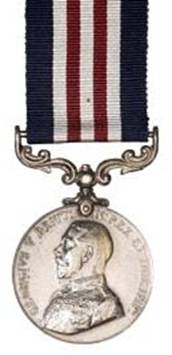
Figure 5. The Military Medal of J.T. Matheson.
(Image from the author’s collection)
Matheson's award of the Military Medal was announced on page 3423 in the Supplement to the London Gazette dated 13 March 1919. There is no citation accompanying the award of this medal to 2nd Corporal Matheson. He may have received it for bravery in the field during the final phases of the pursuit of the Germans to Mons, or it may have been awarded to him for sustained bravery in action over a period of time during the war.
The 1914-15 Star: This medal is named to:
26707
SPR.J.T. MATHESON.
R.E.
The British War Medal: This medal is named to:
26707 T-CPL. J.T.
MATHESON R.E.
The Victory Medal: This medal is a name-erased specimen, which was part of Matheson's original group of medals. Apparently he lost his original medal and replaced it with a medal from which the original recipient's name had been removed.
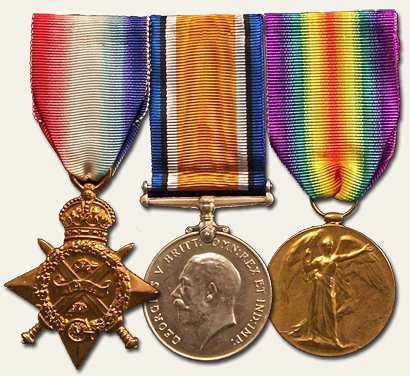
Figures
6. The 1914-15 Star, British War
Medal and Victory Medal
of J.T. Matheson.
(Image from the author’s collection)
It should be noted that all of Matheson's military medals were impressed with the name "Matheson," while sports medals that he received while in the Army are engraved Mathieson and the Rocket Apparatus Volunteer Long Service Medal that he subsequently received was engraved "Matherson." The author has assumed that the Army records are correct and that his name was spelled Matheson.
4. PROMOTIONS AND CONDUCT
Promotions
James Matheson entered the Army as a Sapper and held the rank of 2nd Corporal by the end of the war. Since his service papers were not available at the Public Record Office, his dates of promotion to Lance Corporal and 2nd Corporal are not known. His 1914-15 Star indicates that he was serving as an Acting 2nd Corporal early in the war. The naming on Matheson's British War Medal indicates that by the end of the war he had been appointed a Temporary Corporal. There is no record to indicate that he was promoted to the substantive rank of Corporal before being demobilized.
Conduct
Similarly, lack of service papers does not give any indication of 2nd Corporal Matheson's conduct during the period of this military service. One could assume that as a winner of the Military Medal for his brave conduct in the field and his rank of 2nd Corporal and Temporary Corporal by the end of the war, his conduct was probably "Very Good" if not "Exemplary."
5. EDUCATION AND QUALIFICATIONS
In
the absence of his service records, no specific information is available
regarding Matheson's education or trade qualifications during his period of
military service.
6. MEDICAL INFORMATION
In the absence of his service records, no specific information is available regarding Matheson's medical history during his period of military service.
7. MARRIAGE AND PERSONAL
INFORMATION
In the absence of his service records, no specific information is available regarding Matheson's marital status during his period of military service. Neither of the family trees found on Ancestry.com that could be attributed to Matheson indicates that he was married.
The only personal information available about James Matheson comes from a number of sports medals he won while in the Army. As previously indicated, his father was a member of The Helmsdale Athletic Club and like his father, James seems to have had a keen interest in sports, especially football. He may also have been a hunter, as he was a good shot with the rifle based on the "Best Shot" medal he won during his recruit training.
Along with his military medals and that of his father, the author was fortunate to obtain the following sports medal all named as shown below:
3rd Field Squadron R.E. Armistice Cup Bronze Medal named to J.T. Mathieson, R.E., Belgium on the reverse. This medal is 2 inches in diameter and bears the effigy of two Greek Athletes on the obverse, apparently in a cross-country race. The medal is engraved 1919 in the exergue. Also engraved in the exergue is the name of the medal maker, L. Cariat. The reverse of the medal consists of a crossed laurel and olive branch around the bottom, below a circle, and all surmounted by a mountain at the top of which is a temple (probably the Parthenon). L. Cariat also is engraved near the rim at about 7 o'clock on the reverse of the medal. Matheson's name is misspelled Mathieson on the medal.
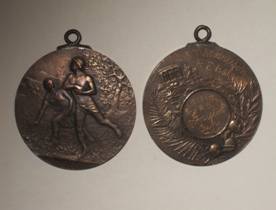
Figure
7. 3rd Field Squadron R.E. Armistice Cup Bronze Medal
(Images from the author’s collection)
4th Army Championship Cup Bronze Medal named to J.T. Mathieson, R.E., Belgium on the reverse. This medal is identical to the one described above in all its other features and again his name is misspelled.
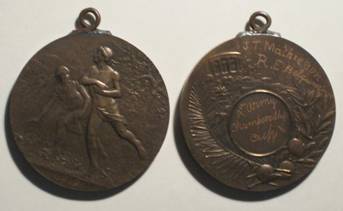
Figure
8. 4th Army Championship
Cup Bronze Medal.
(Images from the author’s collection)
3rd Field Squadron, R.E. Cavalry Corps Silver Medal.
This medal is not named. The
obverse of the medal consists of a laurel wreath and within the wreath the
engraved words:
Cavalry
Corps
R.E.
Football
1919
The
reverse of the medal is plain and engraved with the words:
Winners
3rd Field
Squadron
The medal is hallmarked with a ring suspender and a thin purple ribbon (5/8ths of an inch wide) with two thin lavender stripes.
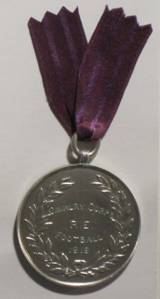
Figure
9. 3rd Field Squadron, R.E. Cavalry Corps Silver Medal
(Image from the author’s collection)
8. POST SERVICE LIFE
Matheson returned home for demobilization and discharge, probably in 1920. Nothing is known about his trade or the type of work he did for a living. It is known that after his discharge he joined the Board of Trade Rocket Life Saving Apparatus Volunteers, the forerunner of the Coastguard Auxiliary Service. He probably served at a lifeboat station somewhere near his home on the North Sea coast of eastern Scotland.[20] The most likely location would have been the Aberdeen Lifeboat Station. This station was one of the earliest in Scotland, being established in 1802 by the Harbour Commissioners. Like the station to the south at Arbroath, the first lifeboat at Aberdeen was built by Henry Greathead. In 1875 a second station was established at Aberdeen and up to 1925 the Aberdeen lifeboat had a record of saving 589 lives.[21]
Matheson's duties at the lifeboat station consisted of manning the rocket life saving apparatus at the station. Lifeboat stations normally consisted of an officer's house, coast guard cottages, the rocket house and a watchtower. In addition to lifeboats, the life saving apparatus consisted of a wagon loaded with ladders, ropes and other equipment for the rescue of people from ships wrecked close to land. A key piece of equipment for rescue operations was the rocket launcher used to send a rescue rope to stricken ships close to the coast. Once a line had been connected between the ship and the shore, a breeches buoy rescue system could be made up and people pulled to safety.[22]
Line rockets competed as throwing devices with other line throwing tools; namely, the Hunt gun, the Manby mortar and the Lyle gun, and eventually replaced them in England by 1878. The line rocket used by James Matheson was placed in a long narrow trough equipped with legs to position it at an angle for flight. The line (known as the whip line) was attached to the rocket and was coiled in a faking ("flaking")[23] box to allow it to deploy untangled after the rocket was fired. The rocket was aimed in such a way as to hit the rigging of the sinking ship or a ship run aground near shore. It was also usually aimed to the windward side of the ship so that there would be a chance of the line being blown to the ship if the rocket missed. If the lifesaver's aim were true with the rocket, the seaman on board the ship would haul in the line to retrieve a pulley (tail block) with an endless line running through it. The line usually had a board attached to it on which the seaman found instructions in English and French that would tell them how to attach the pulley to the mast or some other sturdy part of the ship.[24] The lifesavers on shore then tied a hawser to the line and drew it out to the ship, where the men on board made it fast to the mast about two feet above the tail block. The lifesavers then tied their end of the hawser to a double pulley on a buried sand anchor and placed an X-shaped crotch under the hawser to raise it above the level of the sea. The hawser was then pulled taut using the double pulley.[25]
A breeches buoy was then used to move people from the stricken ship to the shore one at a time. The breeches buoy consisted of a common cork-filled life ring (a circular life preserver) with a pair of short-legged oversize canvas pants sewn inside. The person being moved from the ship to the shore got into the breeches buoy as if putting on a pair of trousers.[26] The breeches buoy hung from the hawser by means of a free-running block known as a traveler block. The lifesavers on shore pulled the breeches buoy out to the wrecked ship using the line attached to the traveler block and to the tail block aboard the ship. The victims aboard the ship were then saved one at a time by sitting in the trouser legs of the breeches buoy and being pulled ashore. It was possible at times for two persons to use the breeches buoy by each putting a one leg into the breeches buoy at the same time and holding on to the lifts of the buoy. Ship captains were to ensure that women and children landed first and that if two persons used the breeches buoy, children would be held in the arms of an adult or were securely lashed to the buoy.
In lieu of the breeches buoy a life car was sometimes used. The life car could rescue usually four to six people at a time. The car consisted of a cone-shaped fuselage constructed of metal, which resembled a covered boat with a hatch through which the passengers could enter it. It was heavy and clumsy to use and required a stouter hawser than the breeches buoy. It was also a terrifying experience for the people who rode inside the life car, as it was coffin-like and pitch black inside. A claustrophobic person must have been terrified; dangling above the sea from a rope with the life car bobbing and swaying as it was pulled to shore.
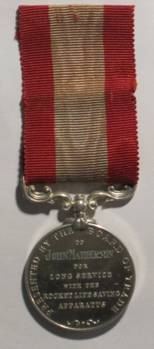
Figure 10. Rocket Apparatus
Volunteer Long Service Medal.
(Image from the author’s collection)
In dire circumstances, when the ship seemed to be about to break apart, the lifesavers frequently dispensed with the hawser and sent the breeches buoy out to the ship on the whip line. The victims aboard ship were then drawn to the shore directly through the surf, without the benefit of the line being raised to any height above the sea.[27] Needless to say this was a somewhat more risky way of performing the rescue, but sometimes necessary when time did not allow for the heavy hawser to be pulled out to the ship.
After his discharge from the Army, James Matheson performed life saving duties using equipment and methods much like those described above. He served as a volunteer at a life saving station for 20 years, thereby qualifying for the Rocket Apparatus Volunteer Long Service Medal.[28] Although it is not known for certain, James Matheson could have served at the Aberdeen Lifeboat Station from about 1920 to 1940. During this period the men of the station took part in rescues involving the Glen Cova (1930), the trawler George Stroud (1936), the steamer Fairy (1937) and the trawler Roslin (1937).
The First Battle of Ypres
During the Battle
at Ypres from 22 April to 25 May 1915 Sapper Matheson’s unit took part in the
actions at St. Julien (24 April – 4 May), Frezenberg (8-13 May) and
Bellewaarde (24-25 May).
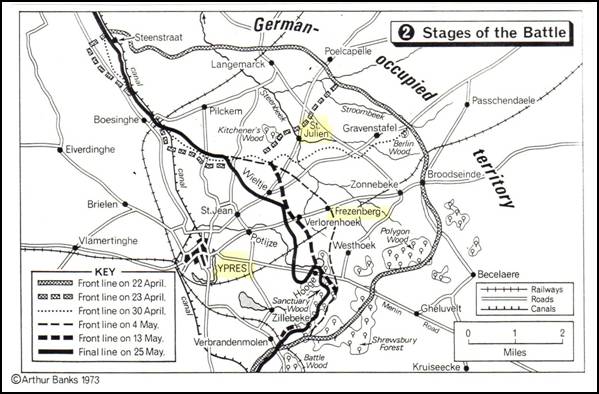
Figure 11. Stages of the
First Battle of Ypres.
(Map from A Military Atlas of the First World War by A. Banks)
REFERENCES
Books
1. BANKS, A.
A Military Atlas of the First World War.
Heinemann Educational Books, London, 1975.
3. BECK, A.F.
History of the Great War.
Order of Battle of Division. Part
I - The Regular British Divisions. The
Sherwood Press Ltd., Nottingham, reprint of the 1934 edition.
4. GRIERSON, J. MONCRIEFF.
Records of the Scottish Volunteer
Force, 1859-1908. Frederick
Muller, Ltd., London, 1972, pp. 152-153.
5. History of the Corps of Royal Engineers.
Volume V. The Institution of
Royal Engineers, Chatham, Kent, 1952, p. 248.
6. MOBLEY, J.A.
Ship Ashore! The U.S.
Lifesavers of Coastal North Carolina. North
Carolina Department of Cultural Resources, Raleigh, 1996.
7. SHANKS, R., YORK, W. and
SHANKS, L.W. The U.S. Life-Saving
Service: Heroes, Rescues and Architecture of the Early Coast Guard.
Costaño Books, Petaluma, 2000.
Computer Software
Soldiers Died in the Great War.
The Naval & Military Press Ltd., Heathfield, East Sussex, 1998.
Documents
1. Medal Index Card, T/Corporal James T. Matheson, MM, R.E.
2. Royal Engineers Medal Roll, 1914-15 Star.
3. Royal Engineers Medal Roll, British War Medal and Victory Medal.
4.
War Diary, 3rd Field Squadron, Royal Engineers,
September 1914 to Mau y 1919.
Internet Web Sites
1. The Amlwch Coastguard Station.
http://www.copperkingdom.fsnet.co.uk/coastguard.htm
2. GRAY, M.G. History of the Aberdeen Lifeboat Station.
http://www.btinternet.com/~mark.g.gray/history.htm
3. MICROSOFT EXPEDIA MAPS.
http:\www.expediamaps.com
4. British Jews in the First World War.
https://www.jewsfww.uk/victor-herman-simon-mc-2932.php
Periodicals
1.
London Gazette, 13 March 1919, pp. 3415 and 3423.
2. Royal Engineers Journal, June 1926. Brief History of the Royal Engineers with Cavalry in France During the War, 1914-18 by Colonel W.H. Evans, D.S.O. Institution of Royal Engineers, Chatham, Kent.
3. Royal Engineers Journals, 1925-1932 Battle Honours of the Royal Engineers. Institution of Royal Engineers, Chatham, Kent.
[1] Alternate spellings: Matherson and Mathieson as shown on the medals.
[2] Now The National Archives.
[3] The full title of this unit was the 1st Caithness Royal Garrison Artillery (Volunteers) (Caithness and Sutherland).
[4] This medal is in the author's collection and was purchased with the group of medals awarded to his son.
[5]
Records
of the Scottish Volunteer Force, 1859-1908
by Lt. Gen. Sir James Moncrieff Grierson, K.C.B., C.V.O., C.M.G., A.D.C.
Frederick Muller, Ltd., London,
1972, pp. 152-153.
[6] This watch fob is in the author’s collection.
[7] This medal is in the author's collection.
[8] His posting to this unit is based on the London Gazette entry where his award of the Military Medal was announced in March of 1919.
[9] The British 3rd Cavalry Division had no Commander Royal Engineers (CRE).
[10] This statement is based on the fact that he was awarded the 1914-15 Star and not the 1914 Star. Additionally, based on his Regimental Number, he would not have been able to complete his recruit training before the squadron was deployed to France with the 3rd Cavalry Division.
[11] The references are vague on this. There is a Ludgershall in Buckinghamshire and in Wiltshire. It is uncertain near which town the division was formed.
[12] Unit war diary.
[13] Later, Lieutenant Colonel, DSO and bar.
[14] Unit war diary and Commonwealth War Graves Commission.
[15] Battle Honours of the Royal Engineers. The Royal Engineer Journal, Institution of Royal Engineers, Chatham, Kent, 1925-1932.
[16] History of the Corps of Royal Engineers. Volume V. The Institution of Royal Engineers, Chatham, Kent, 1952, p. 248.
[17] Unit war diary.
[18] This is a rather unusually worded citation. It says “For conspicuous ability and energy . . .” rather than for conspicuous “bravery,” the word usually used in a Military Cross citation. The wording implies that he received the award for hard work rather than gallantry.
[19] Soldiers Died in the Great War.
[20] In October of 2002 the author was fortunate enough to visit the Chicamacomico Lifesaving Station at Rodanthe on the Outer Banks of North Carolina. At Chicamacomico, he met Ms. Linda Molloy who guided him through the station and explained the history and procedures of the lifesaving operations that took place there and along the Outer Banks. The description of the rocket apparatus, breeches buoy and life car contained in this narrative is based primarily on the procedures used in the United States. However, the operations of life saving stations in the United Kingdom during the same periods of time were very similar, if not identical. The author does not believe that he has gone too far astray in describing the type of apparatus that James Matheson must have used along the east coast of Scotland during his time at a lifesaving station there.
[21] GRAY, MARK G. History of the Aberdeen Lifeboat Station. RNLI HQ, Poole.
[22] The Amlwch Coastguard Station.
[23] The name of the line differed between the United States and the United Kingdom. Either word could be considered appropriate as the Chambers English Dictionary gives the following definitions for each:
· Faking: n. a coil or rope. v.t. to fold or coil. From the Scottish, faik - to fold.
· Flaking: n. a frame or rack.
In fact, a faking or flaking box was a frame or rack used to coil rope; hence, either or both names seem appropriate.
[24] Historical records indicate that many lives were lost due to the failure of the crewmen aboard ships to properly secure the line.
[25] MOBLEY, J.A., p. 38.
[26] SHANKS, YORK and SHANKS, p. 69.
[27] MOBLEY, J.A., p. 38-39.
[28] This medal is in the author's collection.